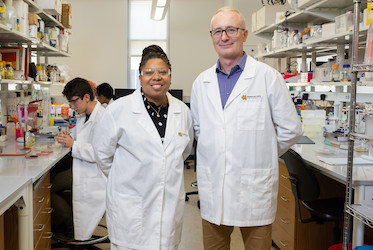
Finding New Clues
KENNESAW, Ga. | Sep 24, 2018
Researcher sheds light on mysteries of black holes
New research into black holes may shed light on the origins of life in the universe, according to David Garofalo, Kennesaw State University assistant professor of physics. Garofalo recently co-authored a paper published in the Monthly Notices of the Royal Astronomical Society.
“Our research shows that the breaking up or ripping of magnetic fields near black holes may explain the way jets of energy come from black holes or contribute to that understanding,” said Garofalo, who conducts research in black hole astrophysics.

“There are active galaxies where this is happening, but ours is not one of them,” he said, referring to the jets emanating from the black holes. “The active galaxies producing jets are only a small fraction of all active galaxies – about one-fifth of the 10 percent that are active. Most active galaxies shine brightly as stuff falls in, but mysteriously don’t produce jets.”
Black holes, which exist throughout the universe, are created by dying stars. The first ones probably came into existence some 300 million years after the Big Bang set our universe in motion. As the star’s fuel is spent, strong gravitational forces squeeze the remaining matter so densely that no light can be emitted.
“A black hole is a region inside of a boundary where time as we know it has stopped,” Garofalo said. “Starting in the early 1960s, astronomers discovered that 10 percent of galaxies are really strange in that they are emitting huge amounts of energy.”
According to Garofalo, the largest black holes detected exceed 10 billion times the mass of our Sun.
“Scientists are able to see the radio emissions produced by charged particles spiraling around the magnetic fields of black holes,” he said. “The active region more generally is not just made up of the jet but also of the hot material falling into the black hole. These black holes are sending out energy, and by using X-ray surveys we can see the jet is a high-energy gamma ray. We can also see it in some wavelengths of light emitted, too.”
Why some active galaxies produce jets while others don’t remains a mystery to scientists.
“Individual researchers, like myself, might claim they know why some active galaxies produce jets so now our goal is to convince others of that,” he said.
NASA's Chandra X-ray Observatory and several telescopes confirmed the existence of these jets from black holes earlier this year. The space agency even had a little fun describing the news, saying “astronomers have caught a supermassive black hole snacking on gas and then "burping" — not once but twice….”
Garofalo said his team’s research into the magnetic fields may explain “the cyclical behavior of smaller black holes by these magnetic fields being ripped apart near black holes.”
“The universe appears to follow certain cycles and it now seems reasonable that black holes are part of that cycle,” he said. “Ultimately, we might find that life in the universe is tightly connected to powerful outflows from black holes.”
Garofalo, who did postdoctoral work as a NASA fellow and as a Caltech Postdoctoral Scholar at the Jet Propulsion Laboratory in Pasadena, said the largest black holes, termed “supermassive,” contain more mass than one million suns combined.
“Astronomers think every large galaxy has one such black hole at its center and millions of black holes in each galaxy.”
Formed some 13.6 billion years ago – about 200 million years after the Big Bang – our own Milky Way is one of these large galaxies. Its supermassive black hole is called Sagittarius A.
“In the long term, we want to understand how much black holes matter to the whole universe and to life in particular, Garofalo said. “This matters to the curious person because it answers questions about where we came from, how we emerged in the universe.”
This has been one of the central themes guiding Garofalo’s research for more than a dozen years now.
“I study black holes because I was always interested in applications of the theory of relativity, but the original idea for this specific research should really be credited to my co-authors. My contribution involved producing the mathematical structure appropriate for a near-black hole study of the process.”
The math involves something called “scale invariance.” Simply put, it means that no matter whether you are researching a small black hole or a supermassive one, they will behave similarly.
“If our results hold, scale invariance implies something about the super large black holes which would give us new insights into the behavior of the most spectacular jets observed in the universe,” he said.
However, according to Garofalo, many in the scientific community do not subscribe to this holistic approach to black holes.
“The universe appears to follow certain cycles and it now seems reasonable that black holes are part of that cycle. Ultimately, we might find that life in the universe is tightly connected to powerful outflows from black holes. In the long term we want to understand how much black holes matter to the whole universe and to life in particular,” Garofalo said.
“I'm not sure about the next discovery, but one of my goals is to get people in the sciences to recognize the value of ideas which, with the advent of supercomputers, seems to be taking a back seat,” said Garofalo.
– Robert S. Godlewski
Photos by Lauren Kress
Related Stories
A leader in innovative teaching and learning, Kennesaw State University offers undergraduate, graduate and doctoral degrees to its more than 45,000 students. Kennesaw State is a member of the University System of Georgia with 11 academic colleges. The university’s vibrant campus culture, diverse population, strong global ties and entrepreneurial spirit draw students from throughout the country and the world. Kennesaw State is a Carnegie-designated doctoral research institution (R2), placing it among an elite group of only 7 percent of U.S. colleges and universities with an R1 or R2 status. For more information, visit kennesaw.edu.



















